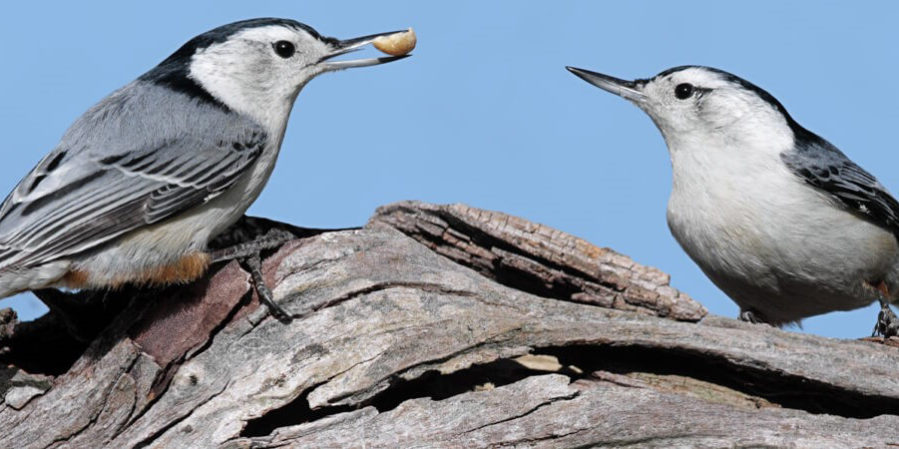Bird of The Week: White-breasted Nuthatch
SCIENTIFIC NAME: Sitta carolinensis
POPULATION: 9.4 million
TREND: Increasing
HABITAT: Mature deciduous and mixed forests, edges, suburbs, and parks with large trees
The confiding, acrobatic White-breasted Nuthatch delights many a backyard birder with its head-down antics and nasal calls. Sometimes described as the “upside-down bird” or “wall walker,” this agile little songbird is often seen in the company of other familiar species such as the Downy Woodpecker, Northern Cardinal, and Black-capped Chickadee.
Meet the “Nut-hack”
The word “nuthatch” derives from “nut-hack,” an old English word likely first ascribed to the related Eurasian Nuthatch. This evocative word describes an unusual method of feeding shared by all nuthatch species. These birds wedge their food — nuts, seeds, or insects — into bark crevices, then hammer or “hack” at the food with their strong bills to tear it apart.
While foraging, the White-breasted Nuthatch clambers up and down tree trunks head-first and sidles along large branches, probing gaps and holes in bark for food items.
Generally resident throughout its range, the White-breasted Nuthatch is the most frequently encountered member of its tribe in North America. The nuthatch family in North America also includes the Brown-headed, Pygmy, and Red-breasted Nuthatch.
The oldest known White-breasted Nuthatch was nearly ten years old, according to scientists at Cornell Lab of Ornithology — an extraordinary age for such a small bird!
From Central Park to the Cascades
Eleven subspecies of White-breasted Nuthatch are recognized and are divided into three groups, based on call, plumage variation, and bill length: Eastern, Central, and Pacific.
Across its wide range, the White-breasted Nuthatch inhabits a variety of forest types, from New York City’s Central Park woods to semi-open, semi-arid habitats in the Rockies. Most eastern forests host this species, as long as there are maturing second-growth deciduous or mingled deciduous-coniferous trees. It occurs in forests where Ponderosa Pine is the dominant tree species, for example, along the eastern slopes of the Cascade Range in Washington.
Outside its breeding season, the White-breasted Nuthatch often forages in mixed flocks with other small birds such as the Golden-crowned Kinglet, Brown Creeper, and Carolina Wren, as well as other resident cavity nesters, including Carolina Chickadees, Tufted Titmice, and other nuthatches.
Vocal Variations
Nuthatches make three kinds of vocalizations: calls, songs, and foraging, or feeding, calls. These vocalizations vary by region. In the East, the typical call is a slow “yank, yank, yank,” whereas the Interior and Western subspecies gives a higher-pitched call repeated in a quick series.
The song, typically given in late winter and early spring, is a series of six to eight notes, sung only by the male. These birds also make a quiet, short call while foraging.
Nest Best Practices
White-breasted Nuthatches nest in natural cavities or knotholes, woodpecker holes, or sometimes in nest boxes. The nest site is usually above 15 feet up, and at times as high as 60 feet. The female builds the nest, a cup of twigs and grasses lined with shredded bark, hair, and feathers. There, she usually lays between five and nine eggs, which hatch after about two weeks of incubation.
White-breasted Nuthatch pairs display an interesting housekeeping behavior known as “bill sweeping.” The birds rub their nest-hole entrance with bits of fur, plants, or crushed insects, sometimes also daubing the area with mud. Scientists believe nuthatches use this behavior to mask or remove their scent around the nest, helping to prevent detection by predators, such as snakes, and nest competitors, chiefly squirrels.
Common, but Not Immune
The conservation consortium Partners in Flight has reported the good news that, in recent years, the resident White-breasted Nuthatch has increased in population. At the same time, many migratory birds, such as Wood Thrush and Hooded Warbler, have declined precipitously, contributing to the astounding loss of nearly 3 billion birds in North America in the past 50 years.
Like the adaptable Blue Jay and American Robin, the White-breasted Nuthatch seems to thrive in diverse habitats, including forests, park-like settings, and even suburbs, as long as mature trees are present. Although it remains common, this bird faces the same threats as less-adaptable species, particularly predation by cats and collisions with glass.
Fortunately, ABC has a number of programs in place to reduce these threats, including our Cats Indoors program, which encourages pet owners to keep cats and birds safe, and our Glass Collisions program, which promotes solutions to keep birds from hitting windows.
Source: American Bird Conservancy (abcbirds.org)


